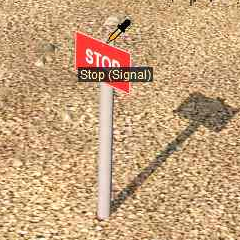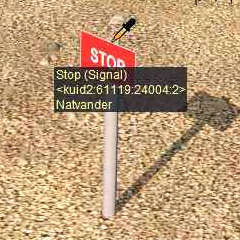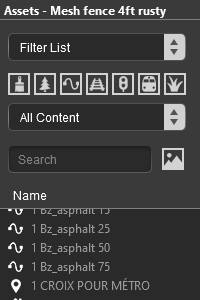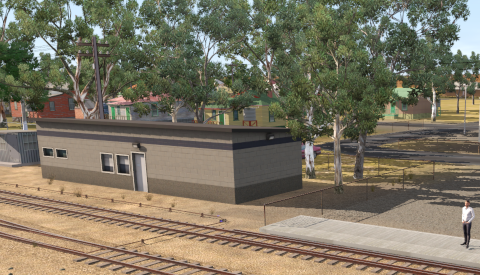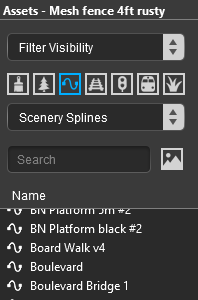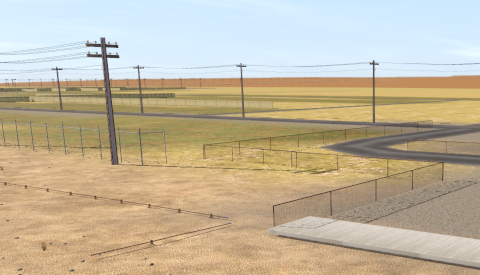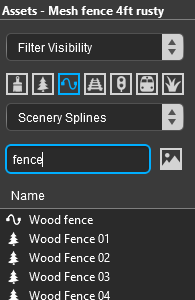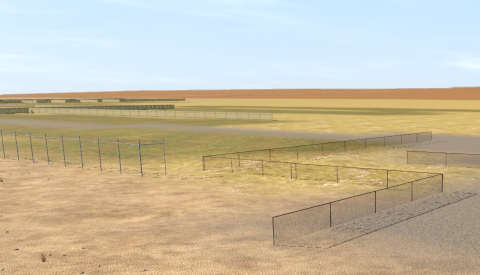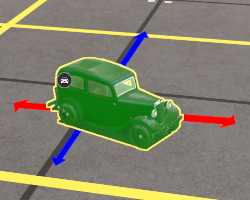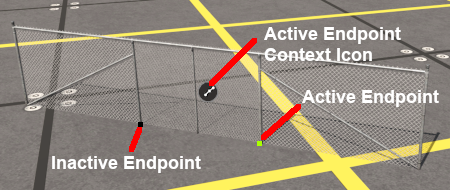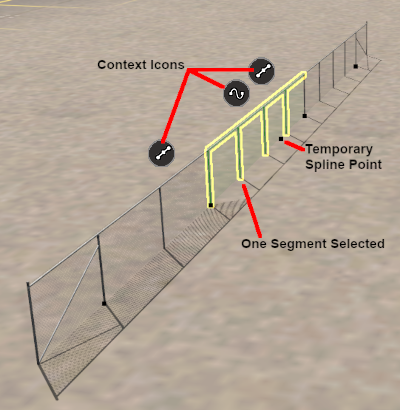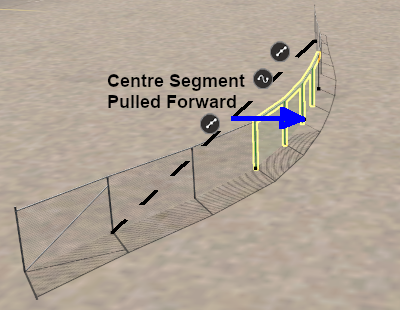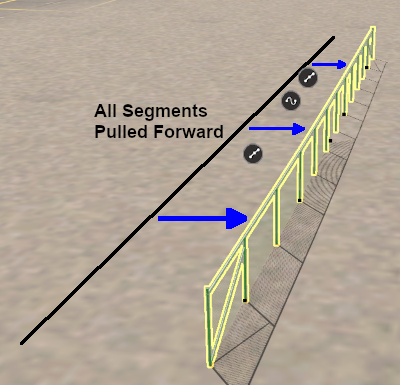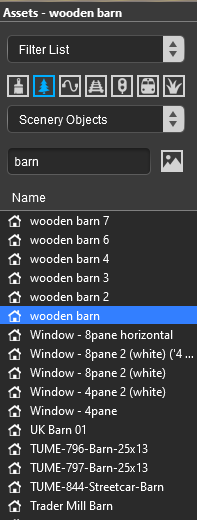The information in this Wiki Page applies to Surveyor 2.0 (S20) as found in Trainz Plus.
This document is still being written
The Tools Palette
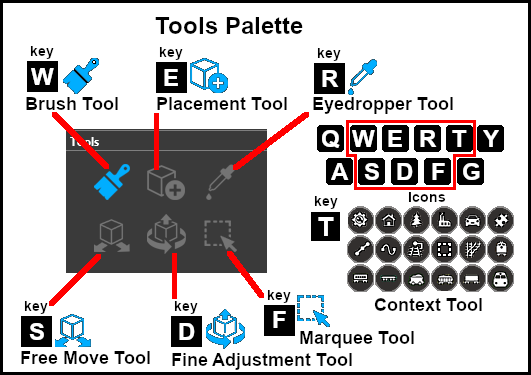 |
 |
Notes: Palettes
|
|
If the Tools Palette is not shown on the screen, then:-
 |
| 1. |
open the Window Menu from the menu icons at the top of the screen |
| |
- visible palettes with have ticks next to their names
|
| 2. |
Left click on the item Tools Palette |
| |
- this will add a tick and make the Tools Palette visible
|
| 3. |
make sure that the Tool Options Palette is also visible |
|
|
|
|
The Brush Tool
 |
Keyboard Shortcut: W |
The Brush Tool "Paints" the Terrain, Ground Textures, Effect Layers and Scrapbook Scenes in a Route |
When selected, the Brush Tool has two drop down menu lists.
 |
The first drop down menu will set the "Brush Target" which is the type of brush.
The Targets are:- |
 |
Ground Height |
 |
Ground Texture |
 |
Scrapbook Data |
 |
<List of Effect Layers> |
 |
Edit Effect Layers |
|
 |
 |
If you have any Effect Layers then they will appear as Targets in this drop down list. Select an Effect Layer to use the brush to paint with that layer. |
|
|
|
Ground Height
This brush tool uses the Tool Options Palette. If this palette is not visible on the screen then refer to  Notes: Palettes at the top of this document. Notes: Palettes at the top of this document.
|
|
When the Ground Height Target is selected, the second drop down box will give a choice of several Ground Height tools.
| The choices are:- |
 |
Height Up |
 |
Height Down |
 |
Set Height |
 |
Grade |
|
 |
| The available brush tool options are shown in the Tool Options Palette with a Gold coloured icon next to their names. Those options that have their icon greyed out will be ignored, but they can still be edited. |
Height Up/Height Down
 |
Set Height
 |
Grade
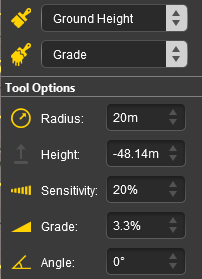 |
| Radius |
the brush radius (metres) - see Notes: below |
|
|
| Height |
the brush height (metres) |
|
|
| Sensitivity |
the rate at which the height changes |
| Range: |
1% (very slowly) to 100% (very quickly) |
|
| Grade |
slope gradient - see Notes: below |
| Range: |
0% = flat ("Plateau" in Classic) to |
| |
±100% = steep (but not vertical) |
|
| Angle |
grade direction (compass degrees) |
| Range: |
0° (North) to ±359°
a negative value reverses the grade |
|
|
|
 |
Notes:
|
 |
Unlike Surveyor Classic, there appears to be no upper limit to the brush Radius . Brushes of hundreds of metres (even kilometres) in size are possible. However, if you are using the brush to set an entire baseboard, or many baseboards, to a specific height then the Marquee Tool may be a better choice. |
 |
The Grade is defined as vertical rise divided by horizontal distance converted to a percentage figure. So a grade of 100% (the maximum allowed) would mean a slope formed by the height and distance both being the same value (e.g. a height increase of 50m over a distance of 50m). A vertical slope (a cliff) would have an infinite grade which is currently impossible in Surveyor. |
|
Ground Texture
This brush tool uses the Tool Options Palette. If this palette is not visible on the screen then refer to  Notes: Palettes at the top of this document. Notes: Palettes at the top of this document.
|
|
When the Ground Texture Target is selected, the second drop down box will be disabled - there are no brush texture tool choices.
The available brush tool options are shown in the Tool Options Palette with a Gold coloured icon next to their names. Those options that have their icon greyed out will be ignored, but they can still be edited.
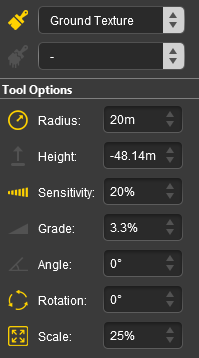 |
| Radius |
the brush radius (metres) - see Notes: below |
|
|
| Sensitivity |
texture transparency |
| Range: |
1% = almost transparent to |
| |
100% = solid (opaque) |
|
| Rotation |
initial rotation angle - see Notes: below |
| Range: |
0° to ±360° (larger angles can be entered) |
|
| Scale |
the texture pattern scaling factor |
| Range: |
0.01% = smallest to 100% = full size |
|
|
|
|
 |
Notes:
|
 |
Unlike Surveyor Classic, there appears to be no upper limit to the brush Radius . Brushes of hundreds of metres (even kilometres) in size are possible. If you are using the brush to paint an entire baseboard, or many baseboards, then the Marquee Tool will be quicker but it will not give the options of changing the scale and rotation. |
 |
The Rotation controls the starting angle for the texture when painting and is often used to avoid pattern repetition. As in Surveyor Classic, holding down the [ or ] keys while painting will continuously change the rotation angle.
 |
Warning: Changing the rotation angle during painting is not recommended for PBR Textures as this will significantly increase the memory useage (each rotation will load in another copy of the PBR texture). |
|
|
Scrapbook Data
 |
The scrapbook contents can be Pasted into a route from the Context Menu of a scenery asset. |
|
This brush tool uses both the Tool Options Palette and the Scrapbook Palette. If these palettes are not visible on the screen then refer to  Notes: Palettes at the top of this document. Notes: Palettes at the top of this document. |
|
The Scrapbook Brush
When the Scrapbook Data Target is selected, the second drop down box will give a choice of two Scrapbook Data tools.
|
The choices are:- |
 |
Scrapbook Brush |
 |
Scrapbook Clone |
|
 |
Scrapbook Brush will resize the scrapbook contents to fit the selected brush shape and size.
 |
If the brush is small then the scrapbook contents will be compressed closer together |
 |
If the brush is large then the contents will be spaced further apart |
 |
Every Left Click will paste another complete scrapbook copy |
 |
The Scale control in the Tool Options Palette is ignored. |
|
Scrapbook Clone will paste the scrapbook at its original size - subject to the Scale setting.
 |
If the brush is the same size as the original scrapbook then a single exact copy will be pasted |
 |
If the brush is smaller than the original scrapbook size then only the central part of the scrapbook will be revealed and more will be added when the brush is moved around until the "painted" area reaches the size of the original. Further painting will clone or tile the scrapbook contents |
 |
If the brush is larger than the original scrapbook size then the contents will be cloned or tiled to fill the set brush size |
 |
The Scale control is not ignored but selecting extremes (e.g. a very large brush and a very small scale value) can cause problems (e.g. system "lockup" while it attempts to scale and clone the scrapbook contents) |
|
|
| The available brush tool options are shown in the Tool Options Palette with a Gold coloured icon next to their names. Those options that have their icon greyed out will be ignored, but they can still be edited. |
Scrapbook Brush
 |
Scrapbook Clone
 |
| Radius |
the brush radius (metres) - see Notes: below |
|
|
| Rotation |
initial rotation angle (degrees) - see Notes: below |
| Range: |
0° to ±360° (larger angles can be entered) |
|
| Scale |
the scrapbook scaling factor |
| Range: |
0.01% = smallest to 100% = full size |
|
| Shape |
brush shape |
| Options: |
 |
Circle and Square will set the brush to the selected shape |
| |
Natural will set the brush to the same shape as the Marquee that created the scrapbook, which may be rectangular. The Radius setting will set the relative brush dimensions |
|
|
|
 |
Notes:
|
 |
Unlike Surveyor Classic, there appears to be no upper limit to the brush Radius . Brushes of hundreds of metres (even kilometres) in size are possible. |
 |
The Rotation controls the starting angle for pasting the scrapbook objects. In Surveyor Classic you could only rotate and paste in 90° increments. In S20 you can rotate and paste at any angle. |
|
The Scrapbook Palette
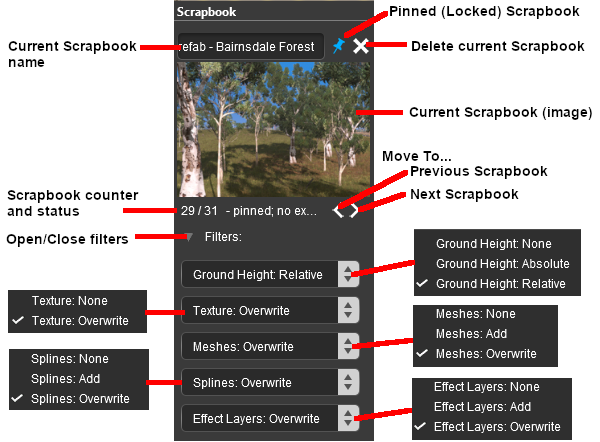 |
|
Scrapbook Pasting Options |
| What Features to Paste |
| |
Ground Height |
terrain height(s) used in the scrapbook |
| |
Texture |
textures used in the scrapbook |
| |
Meshes |
scenery objects (e.g. trees, buildings) used in the scrapbook |
| |
Splines |
spline objects used in the scrapbook |
| |
Effect Layers |
effect layers (TurfFX, Clutter) used in the scrapbook |
| How to Paste Each Feature |
| |
None |
do not paste this feature |
| |
Add |
add this feature to those already present |
| |
Overwrite |
use this feature to replace those already present |
| For the Ground Height feature:- |
| |
Absolute |
use the ground heights in the scrapbook to replace the existing ground heights |
| |
Relative |
modify the existing ground heights according to those used in the scrapbook (to ignore the scrapbook ground heights completely select the option None) |
|
|
Edit Effect Layers...
When this Target is selected, the Edit Effect Layers options will appear. This is the same as selecting Edit Effect Layers ... from the Trainz Edit Menu.
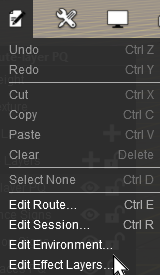 |
- If no Effect Layers are present then you can create a new one
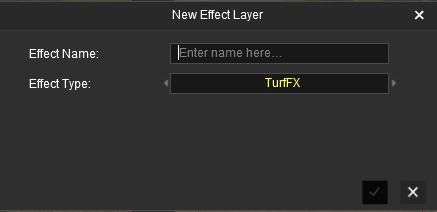 |
- If Effect Layers are present then select one to edit
 |
 |
More information on creating and editing Effect Layers can be found on the Trainz Wiki at:-
|
The Placement Tool
 |
Keyboard Shortcut: E |
The Placement Tool Adds Objects to a Route |
This tool uses the Assets Palette. If this palette is not visible on the screen then refer to  Notes: Palettes at the top of this document. Notes: Palettes at the top of this document.
|
|
When selected, the Placement Tool has no drop down menu lists.
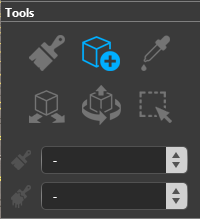 |
 |
More Placement Options |
|
| After an object has been placed in a route its position and height can be changed by:- |
 |
using the  Free Move Tool Free Move Tool |
 |
using the  Fine Adjustment Tool Fine Adjustment Tool |
 |
editing its X Y Z values in  The Info Palette The Info Palette |
 |
selecting the Apply Height option in its Context Menu |
|
|
|
The first step is to identify and select the particular object that you want to add to the route.
Placing a Scenery Mesh Object
Individual "non-spline" scenery objects that are not attached to track are often referred to in Trainz terminology as Scenery Mesh Objects.
 In the Asset Palette either:-
In the Asset Palette either:-
|
|
OR |
Left click the Content Drop-down Box

Then select Scenery Objects
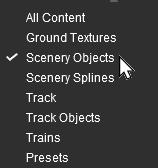
|
|
|
 Shortcut Shortcut
If you already have the same object placed in your route then:-
- select the Eyedropper Tool in the Tools Palette (or press the R key)
- Left click on the existing ojbect in the route
- then Left click on the objects name in the Filter List
This will instantly select that particular object in the Filter List and switch control to the Placement Tool.
Jump to Step  below. below. |
|
|
 |
To narrow down the filter list type part of the object name into the Search Text Box. For example if you have selected Scenery Objects and want to find "barns", then type "barn" (UPPER/lower case does not matter). |
 The final step is to place the selected object into the route. The final step is to place the selected object into the route. |
- If the Placement Tool is not selected then Left click it or press the E key
- Click on the spot where you want to place the object
|
|
 |
Notes:
 |
the Placement Tool will remain on and active until another tool has been selected. So everytime you click another copy of the object (or another object if you change your selection) will be added to the route |
 |
the last object placed will be highlighted (covered in "green/yellow"). This will be the selected object if you switch control to the Free Move Tool or the Fine Adjustment Tool |
|
|
|
Placing a Scenery or Track Spline
Start the process of laying a track or spline by identifying and selecting the spline as described in steps  to
to  above. Then continue by following the steps listed below.
above. Then continue by following the steps listed below.
Spline Segment Heights
When you start adding a spline to a route it will always be placed at the height of the terrain regardless of the Tool Options Height setting.
However, you can set the height of the last segment that was added and this will set the height of all the segments added from that point.
 |
Lay the first spline segment which will be added at the terrain ground height |
 |
Enter a value in the Tool Options Height and press the Enter key |
| The endpoints of the current spline segment will immediately be adjusted to the new height setting |
 |
Continue laying spline segments. Each new segment will be added at the new height
|
|
Placement Tool Options
The Tool Options Palette Height setting for Scenery Mesh Objects, Scenery Splines and Track Splines when using the Placement Tool does not show a gold coloured icon which indicates an "active" control setting but the setting is active.
Mesh Object Tool Options
Spline Tool Options
Splines have two Placement Tool settings in the Tool Options Palette.
 |
Notes:
|
| |
The Grade is defined as vertical rise divided by horizontal distance converted to a percentage figure. So a grade of 100% (the maximum allowed) would mean a gradient formed by both measurements having the same value (e.g. a rise of 50m over a distance of 50m). A vertical grade (such as up a cliff face) would have an infinite grade which is currently impossible in Surveyor. |
|
Deleting Placed Objects
To delete objects either:-
 |
Select the object or a group of objects using either the:-
 |
Free Move Tool (or press S ) OR |
 |
Fine Adjustment Tool (or press D ) |
| |
Multiple objects can be selected by holding down the Shift key when using these tools |
| Then .. |
|
 |
Either:-
 |
Press the Delete key, OR |
 |
Open the Context Menu of the object (or object group) and select the Delete option
|
|
|
|
OR |
 |
Use the Marquee Tool to select the object or a group of objects, then either:-
 |
Press the Delete key OR |
 |
Open the Marquee Context Menu and select the Delete option |
|
|
|
|
The Eyedropper Tool
 |
Keyboard Shortcut: R |
The Eyedropper Tool Identifies and Selects Objects in a Route |
This tool uses the Assets Palette. If this palette is not visible on the screen then refer to  Notes: Palettes at the top of this document. Notes: Palettes at the top of this document.
|
|
When selected, the Eyedropper Tool has no drop down menu lists.
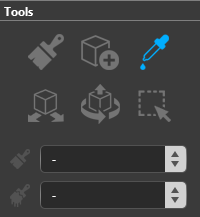
Quick Steps
 With the Eyedropper Tool selected, move the mouse pointer (which will now be an eyedropper symbol) onto any object in view.
With the Eyedropper Tool selected, move the mouse pointer (which will now be an eyedropper symbol) onto any object in view.
Narrowing the Search
Sometimes (or often) a scene will be too crowded with different scenery objects to be able to use the Eyedropper Tool to easily select a single object. In these cases additional options are available to help "remove the clutter".
At the top of the Assets Palette is a drop down box which controls how the Eyedropper Tool works with the filters that you set.
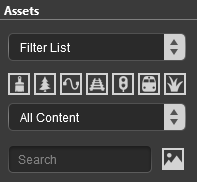 |
The drop down box will provide three options:-
 |
Filter List |
 |
Filter Selection |
 |
Filter Visibility |
|
 |
|
These options work with the Asset Filters to help narrow the search for a specific object or type of object that is in the route.
| Filter List |
this option will have no effect on the operation of the Eyedropper Tool or on the objects displayed on the screen. It is the default setting and any selections made with the eyedropper will be shown in the Assets Palette as described in the section Quick Steps above. |
| Filter Selection |
this option will restrict the Eyedropper Tool to only working on those objects that are in the filtered list. Objects that are not in the filtered list cannot be selected and will not have their details (name, <kuid>, author) displayed on the screen. |
| Filter Visibility |
this option will hide all objects that are not in the filtered list. The only exceptions are Ground Textures and Effect Layers which will be visible but, unless they are also in the filtered list, cannot be selected. |
|
As an example the following images show the progressive application of a Visibility Filter.
The Free Move Tool
 |
Keyboard Shortcut: S |
The Free Move Tool Moves Objects Around a Route |
This tool uses the Tool Options Palette and the Info Palette (to display data only). If these palettes are not visible on the screen then refer to  Notes: Palettes at the top of this document. Notes: Palettes at the top of this document.
|
|
When selected, the Free Move Tool has no drop down menu lists.
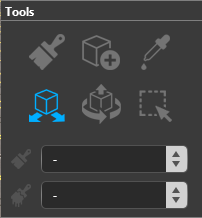 |
 |
Free Move Alternatives |
|
| In addition to the Free Move Tool the position and height of objects can be changed by:- |
 |
using the  Fine Adjustment Tool Fine Adjustment Tool |
 |
editing its X Y Z values in  The Info Palette The Info Palette |
 |
selecting the Apply Height option in its Context Menu |
|
|
|
For Scenery Mesh Objects
Individual "non-spline" scenery objects that are not attached to track are often referred to in Trainz terminology as Scenery Mesh Objects.
Moving a Scenery Mesh Object
Set the Height for a Scenery Mesh Object
When placed in a route by the Placement Tool a scenery object will take the height of the terrain as its set height. It will be fixed to the terrain so when you move it around it will always be at the same height as the terrain it is over.
This can be changed to fix the object to a set height above or below the terrain.
 |
| To set the height of a Scenery Mesh Object:- |
 |
With the scenery object selected, enter a height value into the Tool Options Height text box |
 |
Hit the Enter key |
| The scenery object will now be fixed at the entered height above (or below) the terrain as it is moved around.
|
|
|
Mesh Object Context Menu
A selected scenery object, or a group of selected scenery objects, will have a Context Icon that opens a Context Menu. The icon design will vary between object types.
To open a selected objects Context menu either:-
 |
Left click the Context Icon, OR |
 |
 |
Press the T key |
|
|
Mesh Object Context Menu
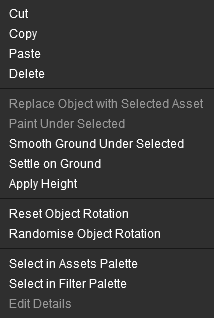 |
| Cut |
remove the selected object or objects and move them into the Scrapbook |
| Copy |
copy the selected object or objects and place them into the Scrapbook |
| Paste |
paste the contents of the current Scrapbook |
| Delete |
delete the selected objects. It has the same effect as pressing the Delete key |
| Replace Object with Selected Asset |
the highlighted object will be replaced with the asset currently selected in the Assets Palette |
| Paint Under Selected |
the texture selected in the Assets Palette will be painted under the highlighted object. The Tool Options for the Brush Tool (Size and Sensitivity) will control how the texture is applied |
| Smooth Ground Under Selected |
changes the height of the terrain under the object to match the set height of the object. If multiple objects at different heights have been selected then the terrain height will be set to match the height of the lowest object |
| Settle on Ground |
sets the height of the objects to match the height of the terrain beneath them ("drops them back to earth") |
| Apply Height |
sets the height of the objects to the value in the Tool Options Height text box |
| Reset Object Rotation |
resets the rotation angle of the objects to their default values |
| Randomise Object Rotation |
applies a random rotation angle to each object |
| Select in Assets Palette |
identifies the selected object in the Asset Palette like the Eyedropper Tool |
| Edit Properties |
opens the Properties window of the selected object |
|
|
For Track Objects
Track Objects (signals, switches, speed signs, etc) are always attached to an existing track. They can be moved to new positions along the track and in Surveyor Classic that was the limit of their movement.
Surveyor 2.0 brings a new freedom of movement to track objects. They can be moved away from the track to the left or right as well as above and below the track. The operation of a track object is not affected by these changes.
The track object can still be moved along the track with the Free Move Tool.
 |
Track objects can be restored to their original height and position (on the track) by opening their Context Menu and selecting:-
 |
Reattach to Track to cancel the both the height and position changes, OR |
 |
Settle on Ground to cancel the height change only |
|
|
Track objects can also be rotated to the opposite side of the track.
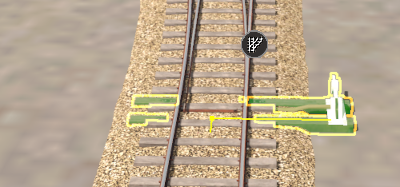 |
| To rotate a track object:- |
 |
Open the track objects Context Menu (click the icon or press the T key) |
 |
Select the option Rotate Trackside |
| Rotating a track object does not change its distance from the track or its height.
|
|
|
For Spline Objects (Including Track)
Scenery splines and track splines are defined by their endpoints. Splines are usually added to a route as a series of joined segments linked at the endpoints.
| Moving a spline can involve moving:- |
 |
an endpoint, OR |
 |
a segment, OR |
 |
multiple segments including the whole length of the spline |
|
Moving Spline Endpoints
Moving Spline Segments
Splines are frequently made of multiple segments joined together. You can easily move a spline by moving its segments, individually or as a group.
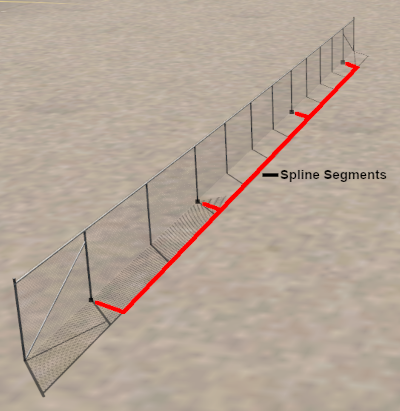 |
 |
Not all splines have endpoints at each ends. As shown in the image on the left, some splines will have an "endcap" that is attached to the start of the first segment and to the end of the last segment. The use of an endcap is a purely cosmetic effect - to give the spline a more distinctive appearance.
|
|
|
 |
| IF you are going to select and move more than one spline segment, then:- |
 |
hold the Shift key down and individually Left click between the endpoints on each additional segment.
The last segment that you click will have the temporary endpoint added. |
 |
To select ALL the segments in a spline, Dbl-Left click on a segment
If the spline contains a junction then this will only select all the segments upto the junction point
The segment that you double-clicked will have the temporary endpoint added |
|
|
|
 |
Use the mouse (Left button held down) to drag the selected segment(s) in any horizontal direction.
| If you had selected:- |
 |
only a single spline segment then only that segment will be moved and the adjacent segments that were not selected will have their shapes (but not their endpoints) adjusted |
 |
multiple spline segments then those segments will be moved and the adjacent segments that were not selected will also have their shapes adjusted |
 |
the entire spline then ALL the segments and endpoints will be moved |
|
Spline Object Context Menu
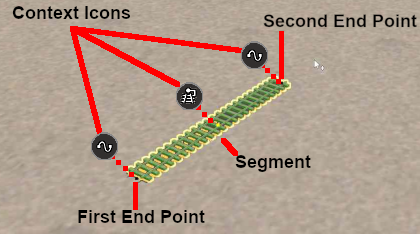 |
| Splines have two different Context Icons that lead to two slightly different Context Menus. |
 |
one context icon and menu for each endpoint |
 |
one context icon and menu for the segment |
| If multiple segments have been selected then the last segment added to the selection will have the context icons. If all the segments were selected by a Dbl-Click then the segment that was clicked will have the icons. |
|
|
Left click on an icon to open its Context Menu.
 Endpoint Context Menu Endpoint Context Menu
 |
 Segment Context Menu Segment Context Menu
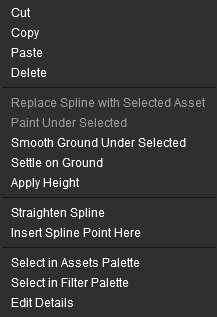 |
| Cut |
remove the segment or segments and move them into the Scrapbook |
| Copy |
copy the segment or segments and place them into the Scrapbook |
| Paste |
paste the contents of the current Scrapbook |
| Delete |
delete the segment, segments or endpoint. It has the same effect as pressing the Delete key |
| Replace Spline with Selected Asset |
the highlighted spline will be replaced with the asset currently selected in the Assets Palette |
| Paint Under Selected |
the texture selected in the Assets Palette will be painted under the highlighted spline segments. The Tool Options for the Brush Tool (Size and Sensitivity) will control how the texture is applied |
| Smooth Ground Under Selected |
changes the height of the terrain under the segment or segments to match the set height of the spline (does not work on endpoints) |
| Settle on Ground |
sets the height of the segment, segments or endpoint to match the height of the terrain beneath them ("drops them back to earth"). When used on segments the spline will follow the height changes of the terrain |
| Apply Height (to this Spline Endpoint) |
sets the height of the segment, segments or endpoint to the value in the Tool Options Height text box |
| Apply Grade to this Spline Endpoint |
sets the height of the endpoint to give a Grade to the surrounding segments that matches the value in the Tool Options Grade text box |
| Straighten Spline |
forces a straight line (as far as possible) between the endpoints of a single segment. This option will be ticked if the segment has already been straightened in which case selecting this option will "un-straighten" the segment and remove the tick |
| Separate Splines |
breaks the spline into two separate splines at the endpoint |
| Merge Splines |
removes the selected endpoint and merges the segments on both sides into one segment. The two segments can also be joined by selecting and deleting the endpoint with the Delete key |
| Insert Spline Point Here |
inserts a new endpoint in a segment at the point where it was clicked. This will create a new segment at the endpoint |
| Select in Assets Palette |
identifies the selected spline in the Asset Palette like the Eyedropper Tool |
| Edit Properties |
opens the Properties window of the selected spline |
|
The Fine Adjustment Tool
 |
Keyboard Shortcut: D |
The Fine Adjustment Tool Makes Fine Detail Adjustments (Position, Rotation, Pitch, Yaw) to Objects in a Route |
When selected, the Fine Adjustment Tool has no drop down menu lists.
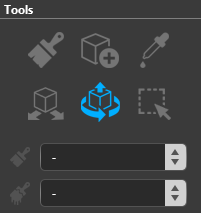 |
 |
Fine Adjustment Alternatives |
|
| In addition to the Fine Adjustment Tool the position and height of objects can be changed by:- |
 |
using the  Free Move Tool Free Move Tool |
 |
editing its X Y Z R P Y values in  The Info Palette The Info Palette |
 |
selecting the Apply Height option in its Context Menu |
|
|
|
The most obvious feature of the Fine Adjustment Tool is the 3D Frame it adds to a selected object.
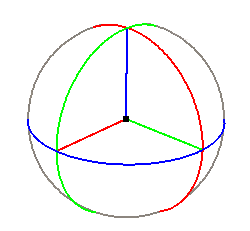 |
The coloured lines in the frame allow manual positional and rotational controls:-
| The Horizontal and Vertical Straight Lines |
| Red Green Blue |
move the object (forward and back) in the direction of the line |
| The Arc Lines |
| Red Green Blue |
rotate the object (clockwise and anti-clockwise) along the arc |
| To use the Fine Adjustment Tool controls:- |
 |
move the mouse pointer onto a coloured line - its colour will change to white |
 |
hold down the Left button |
 |
drag the pointer along the chosen line in the direction required (e.g. Up or Down on the straight blue line) |
|
|
|
For Scenery Mesh Objects
Individual "non-spline" scenery objects that are not attached to track are often referred to in Trainz terminology as Scenery Mesh Objects.
You can move the objects freely in the horizontal plane by using a Left "click and drag" anywhere on the selected object except on a coloured line.
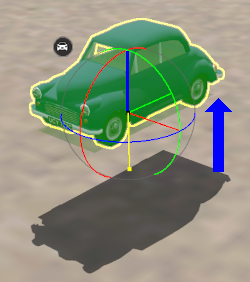
Scenery object after a Blue axis move |
|
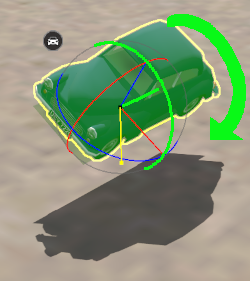
Scenery object after a Green arc rotation |
|
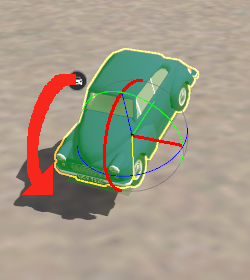
Scenery object after a Red arc rotation |
|
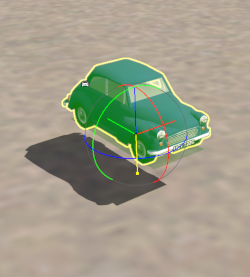
Scenery object after a Blue arc rotation |
 |
Objects can be restored to their original height and rotation settings by opening their Context Menu (see below) and selecting:-
- Reset Object Rotation to cancel the rotation changes, and
- Settle on Ground to cancel the height changes
The Randomise Object Rotation option in the Context Menu only affects rotations around the vertical axis.
|
|
|
Mesh Object Context Menu
 |
| Cut |
remove the selected object or objects and move them into the Scrapbook |
| Copy |
copy the selected object or objects and place them into the Scrapbook |
| Paste |
paste the contents of the current Scrapbook |
| Delete |
delete the selected objects. It has the same effect as pressing the Delete key |
| Replace Object with Selected Asset |
the highlighted object will be replaced with the asset currently selected in the Assets Palette |
| Paint Under Selected |
the texture selected in the Assets Palette will be painted under the highlighted object. The Tool Options for the Brush Tool (Size and Sensitivity) will control how the texture is applied |
| Smooth Ground Under Selected |
changes the height of the terrain under the object to match the set height of the object. If multiple objects at different heights have been selected then the terrain height will be set to match the height of the lowest object |
| Settle on Ground |
sets the height of the objects to match the height of the terrain beneath them ("drops them back to earth") |
| Apply Height |
sets the height of the objects to the value in the Tool Options Height text box |
| Reset Object Rotation |
resets the rotation angle of the objects to their default values |
| Randomise Object Rotation |
applies a random rotation angle to each object |
| Select in Assets Palette |
identifies the selected object in the Asset Palette like the Eyedropper Tool |
| Edit Properties |
opens the Properties window of the selected object |
|
|
For Track Objects
Track Objects (signals, switches, speed signs, etc) are always attached to an existing track. They can be moved to new positions along the track and in Surveyor Classic that was the limit of their movement.
Surveyor 2.0 brings a new freedom of movement to track objects. They can be moved away from the track to the left or right as well as above and below the track. The operation of a track object is not affected by these changes.
 |
 |
Situations where this feature is useful include:- |
 |
placing Track Marks and Triggers above or beside the track so that they are not hidden by consists parked on top of them |
 |
repositioning switches, signals, track signs closer to or further away from the track - particularly useful if the track object was originally created for a different gauge track
|
|
|
 |
Track objects can be restored to their original height and position (on the track) by opening their Context Menu and selecting:-
 |
Reattach to Track to cancel the both the height and position changes, OR |
 |
Settle on Ground to cancel the height change only |
|
|
Track objects can also be rotated to the opposite side of the track.
 |
| To rotate a track object:- |
 |
Open the track objects Context Menu (click the icon or press the T key) |
 |
Select the option Rotate Trackside |
| Rotating a track object does not change its distance from the track.
|
|
|
For Spline Objects (Including Track)
Scenery splines and track splines are defined by their endpoints. Splines are usually added to a route as a series of joined segments linked at the endpoints.
| Moving a spline can involve moving:- |
 |
an endpoint, OR |
 |
a segment, OR |
 |
multiple segments including the whole length of the spline |
|
Moving Spline Endpoints
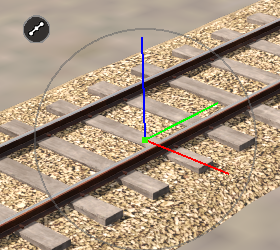 |
| To move an individual spline endpoint:- |
 |
Select the Fine Adjustment Tool. |
 |
Select, Left click on, the spline endpoint to be moved. |
| Note: only the horizontal Red and Green and the vertical Blue lines can be selected. |
 |
"Left Click and Drag" either:-
 |
a coloured line to move the endpoint in that specific direction, OR |
 |
the endpoint itself to move it in any direction in the horizontal plane |
|
|
|
Moving Spline Segments
 |
Notes: |
| |
The Green arc rotation line CANNOT be used on Track splines
|
|
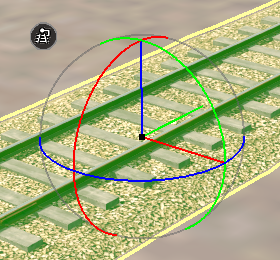 |
| To move spline segments:- |
 |
Select the Fine Adjustment Tool. |
 |
Select, Left click on, the spline segment to be moved. |
 |
"Left Click and Drag" either:- |
| |
 |
a coloured line to move the endpoint in that specific direction, OR |
 |
anywhere in a segment to move it in any direction in the horizontal plane |
|
|
|
 |
To select:-
 |
more than one segment. Hold the Shift key down and individually Left click on each segment |
 |
ALL the segments. Dbl-Left click on a segment. If the spline contains a junction then this will only select all the segments upto the junction point |
|
|
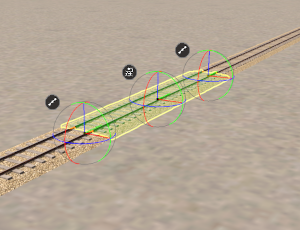 |
Selecting a spline segment with the Fine Adjustment Tool will add a Temporary Endpoint at the point where the segment was clicked.
This will produce 3 Fine Adjustment Tool control frames, one at each end of the segment and one at the click point, as shown in the image on the left. The whole segment can be moved, as shown in the following images, by a Left Click and Drag anywhere within the segment. |
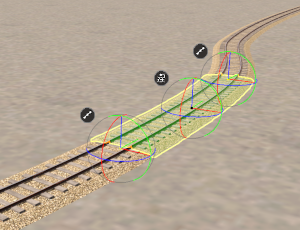
Segment moved to the right along the Red line |
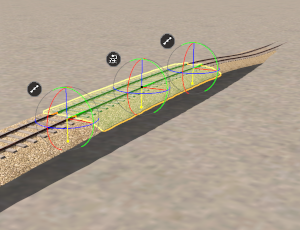
Segment moved up along the Blue line |
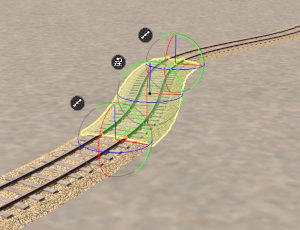
Segment rotated anti-clockwise around the Blue arc |
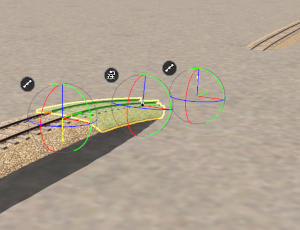
Segment rotated clockwise the Red arc |
This section is still under construction
The Marquee Tool
 |
Keyboard Shortcut: F |
The Marquee Tool Selects Areas of a Route |
This tool uses the Scrapbook Palette. If this palette is not visible on the screen then refer to  Notes: Palettes at the top of this document. Notes: Palettes at the top of this document.
|
|
This section is still under construction
The Info Palette
This palette can be easily overlooked but it has some very useful features.
| Its uses are:- |
 |
to display precise data on the "focus" - the position of the cursor |
 |
to display precise data on the position and attitude of a selected object |
 |
to allow precise control over the position and attitude of a selected object (i.e. it can be used instead of the Free Move Tool and the Fine Adjustment Tool) |
 |
to change the "home" layer and binding layer of a selected object |
 |
to lock and unlock layers |
This section is still under construction
 |
Notes:
For a selected (highlighted) object the following mappings apply regardless of an objects rotation in the horizontal plane:-
- the X axis is the North-South compass direction
- the Y axis is the East-West; compass direction
For a selected (highlighted) object the following mapping applies in relation to how it has been rotated through the vertical plane:-
- the Z axis is the Up-Down direction
|
|
Trainz Wiki
 |
More Tutorials and Guides to Using Trainz
|
This page was created by Trainz user pware in January 2023 and was last updated as shown below.
|















In the Asset Palette either:-
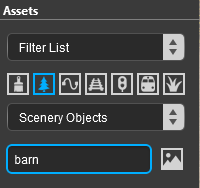
to
above. Then continue by following the steps listed below.


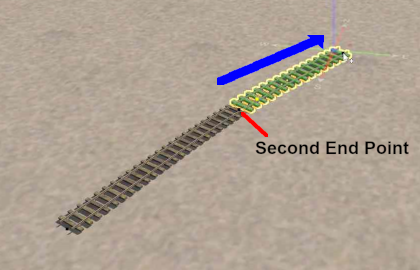
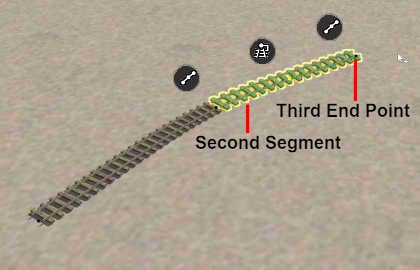

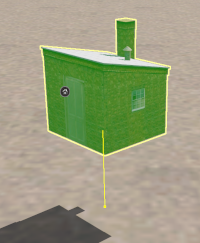
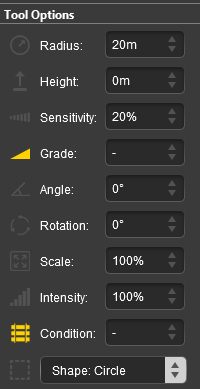

With the Eyedropper Tool selected, move the mouse pointer (which will now be an eyedropper symbol) onto any object in view.
